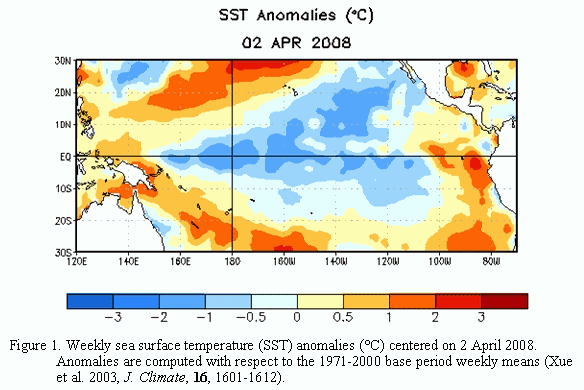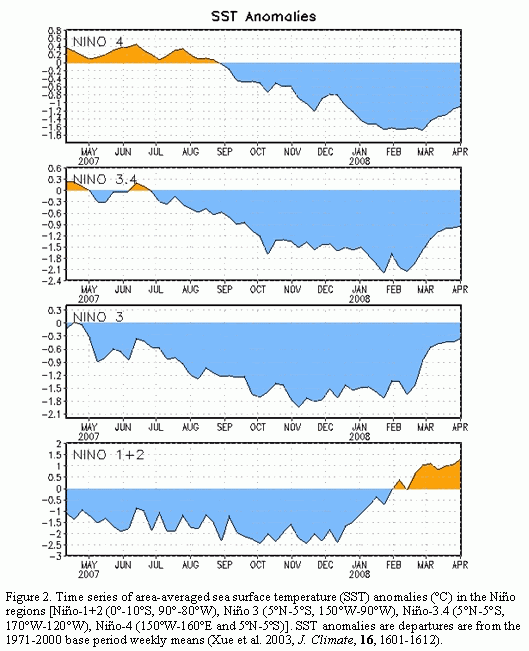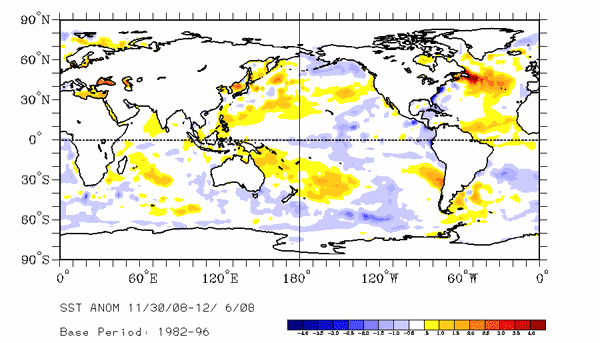oscillation rules as the pacific cools
a cool wedge of lower-than-normal sea-surface heights continues to dominate the tropical pacific, ringed by a horseshoe of warmer waters. The continuation of this long-term cool phase of the pacific decadal oscillation stacks the odds against a wetter-than-average winter/spring in the southwestern united states. Image credit: Nasa/jpl
december 09, 2008
pasadena, calif. -- the latest image of sea-surface height measurements from the u.s./french jason-1 oceanography satellite shows the pacific ocean remains locked in a strong, cool phase of the pacific decadal oscillation, a large, long-lived pattern of climate variability in the pacific associated with a general cooling of pacific waters. The image also confirms that el niño and la niña remain absent from the tropical pacific.
The new image is available online at:
http://www.nasa.gov/topics/earth/features/20081209.html .
The image is based on the average of 10 days of data centered on nov. 15, 2008, compared to the long-term average of observations from 1993 through 2008. In the image, places where the pacific sea-surface height is higher (warmer) than normal are yellow and red, and places where the sea surface is lower (cooler) than normal are blue and purple. Green shows where conditions are near normal. Sea-surface height is an indicator of the heat content of the upper ocean.
The pacific decadal oscillation is a long-term fluctuation of the pacific ocean that waxes and wanes between cool and warm phases approximately every five to 20 years. In the present cool phase, higher-than-normal sea-surface heights caused by warm water form a horseshoe pattern that connects the north, west and southern pacific. This is in contrast to a cool wedge of lower-than-normal sea-surface heights spreading from the americas into the eastern equatorial pacific. During most of the 1980s and 1990s, the pacific was locked in the oscillation's warm phase, during which these warm and cool regions are reversed. For an explanation of the pacific decadal oscillation and its present state, see:
http://jisao.washington.edu/pdo/ and
http://www.esr.org/pdo_index.html .
Sea-surface temperature satellite data from the national oceanic and atmospheric administration mirror jason sea-surface height measurements, clearly showing a cool pacific decadal oscillation pattern, as seen at:
http://www.cdc.noaa.gov/map/images/sst/sst.anom.gif .
"this multi-year pacific decadal oscillation 'cool' trend can cause la niña-like impacts around the pacific basin," said bill patzert, an oceanographer and climatologist at nasa's jet propulsion laboratory, pasadena, calif. "the present cool phase of the pacific decadal oscillation will have significant implications for shifts in marine ecosystems, and for land temperature and rainfall patterns around the pacific basin."
according to nathan mantua of the climate impacts group at the university of washington, seattle, whose research contributed to the early understanding of the pacific decadal oscillation, "even with the strong la niña event fading in the tropics last spring, the north pacific's sea surface temperature anomaly pattern has remained strongly negative since last fall. This cool phase will likely persist this winter and, perhaps, beyond. Historically, this situation has been associated with favorable ocean conditions for the return of u.s. West coast coho and chinook salmon, but it translates to low odds for abundant winter/spring precipitation in the southwest (including southern california)."
jason's follow-on mission, the ocean surface topography mission/jason-2, was successfully launched this past june and will extend to two decades the continuous data record of sea surface heights begun by topex/poseidon in 1992. The new mission has produced excellent data, which have recently been certified for operational use. Fully calibrated and validated data for science use will be released next spring.
Jpl manages the u.s. Portion of the jason-1 mission for nasa's science mission directorate, washington. Jpl is managed for nasa by the california institute of technology in pasadena.
For more information on nasa's ocean surface topography missions, visit
http://sealevel.jpl.nasa.gov/ . To view the latest jason-1 data, visit
http://sealevel.jpl.nasa.gov/science/jason1-quick-look/ .
 NOOA Climate Prediction Center - El Niño / Southern Oscillation (ENSO)
NOOA Climate Prediction Center - El Niño / Southern Oscillation (ENSO) BOM Australia Seasonal Outlooks ENSO Wrap-Up
BOM Australia Seasonal Outlooks ENSO Wrap-Up NOAA Climate Prediction Center - NAO (North Atlantic Oscillation)
NOAA Climate Prediction Center - NAO (North Atlantic Oscillation) North Atlantic Oscillation
North Atlantic Oscillation The Arctic Oscillation (AO) and the North Atlantic Oscillation (NAO)
The Arctic Oscillation (AO) and the North Atlantic Oscillation (NAO) North Atlantic Oscillation
North Atlantic Oscillation Climate Prediction Center - Arctic Oscillation
Climate Prediction Center - Arctic Oscillation The Arctic Oscillation (AO) and the North Atlantic Oscillation (NAO)
The Arctic Oscillation (AO) and the North Atlantic Oscillation (NAO) Arctic Oscillation (AO) time series
Arctic Oscillation (AO) time series Antarctic Oscillation - Climate Prediction Center
Antarctic Oscillation - Climate Prediction Center Climate Prediction Center - Pacific/North American Pattern
Climate Prediction Center - Pacific/North American Pattern NOOA Climate Prediction Center - El Niño / Southern Oscillation (ENSO)
NOOA Climate Prediction Center - El Niño / Southern Oscillation (ENSO) BOM Australia Seasonal Outlooks ENSO Wrap-Up
BOM Australia Seasonal Outlooks ENSO Wrap-Up NOAA Climate Prediction Center - NAO (North Atlantic Oscillation)
NOAA Climate Prediction Center - NAO (North Atlantic Oscillation) North Atlantic Oscillation
North Atlantic Oscillation The Arctic Oscillation (AO) and the North Atlantic Oscillation (NAO)
The Arctic Oscillation (AO) and the North Atlantic Oscillation (NAO) North Atlantic Oscillation
North Atlantic Oscillation Climate Prediction Center - Arctic Oscillation
Climate Prediction Center - Arctic Oscillation The Arctic Oscillation (AO) and the North Atlantic Oscillation (NAO)
The Arctic Oscillation (AO) and the North Atlantic Oscillation (NAO) Arctic Oscillation (AO) time series
Arctic Oscillation (AO) time series Antarctic Oscillation - Climate Prediction Center
Antarctic Oscillation - Climate Prediction Center Climate Prediction Center - Pacific/North American Pattern
Climate Prediction Center - Pacific/North American Pattern









 mas depois alguma estabilidade a partir de dia 1.
mas depois alguma estabilidade a partir de dia 1.










